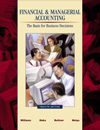Chapter 15 - Summary LO 1 Define four mechanisms companies use to globalize their business activities. Companies globalize their business activities through exporting, licensing,
joint ventures, and wholly owned subsidiaries. Multinational companies use a
global sourcing approach across their international value chain. LO 2 Identify how global environmental forces - (a) political and legal systems,
(b) economic systems, (c) culture, and (d) technology and infrastructure - affect
a company's ability to compete globally. Countries use their political and legal systems to transfer and control business
assets. Market versus centrally planned economic systems create different demands
on business enterprises. Culture influences business relationships through beliefs
and expectations of customers and business associates. The technology and infrastructure
of each global location will affect the type and costs of business activities. LO 3 Demonstrate how to convert an amount of money from one currency to another. To convert a foreign currency to an equivalent dollar amount, multiply the
foreign currency by the foreign exchange rate. To convert a dollar amount into
an equivalent amount of foreign currency, divide the dollar amount by the exchange
rate. LO 4 Compute gains or losses on receivable or payables that are stated in a foreign
currency when exchange rates fluctuate. The receivable or payable is recorded on the date the transaction is agreed
to using the prevailing exchange rate. When exchanging cash completes the transaction,
the exchange rate at the completion date is used to record the cash flow; the
difference between the cash exchanged and the receivable or payable is recorded
as a foreign exchange gain or loss. LO 5 Describe several techniques for "hedging'' against losses from fluctuations
in exchange rates. Hedging is offsetting the potential for losses from foreign exchange rate fluctuations.
It can be accomplished by having offsetting receivables and payables in the
foreign currency or by buying or selling foreign currency future contracts. LO 6 Understand how global sourcing increases product cost complexity. When some of the activities of designing, developing, producing, marketing,
and servicing a product or service occur in more than one country, then global
considerations affect product costs. These considerations include foreign exchange
gains and losses, taxes, import and export duties, trade agreements, foreign
trade zones, and limitations on currency flows. LO 7 Explain the importance of the Foreign Corrupt Practices Act. The FCPA prohibits influence peddling through bribery in international locations.
The act requires companies engaged in global business activities to maintain
good record keeping and adequate internal controls to safeguard company assets. In this chapter, we introduced basic international business terminology and
ideas. We discussed the variety of global business environments companies face
when creating international business opportunities. The variety of environments
causes differences in externally reported accounting information and internal
accounting information use and demand. In the remaining chapters, we will discuss
in more detail internal accounting information use. Keep in mind the international
dimensions discussed here and question their impact on the ideas presented in
the rest of this book. | 


 2002 McGraw-Hill Higher Education
2002 McGraw-Hill Higher Education